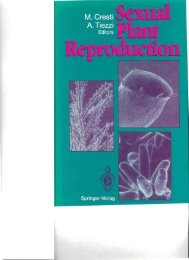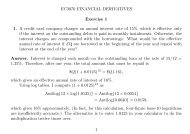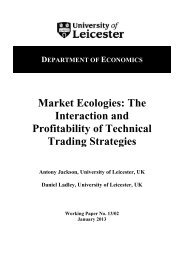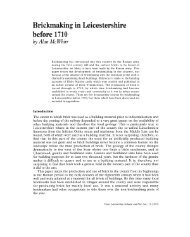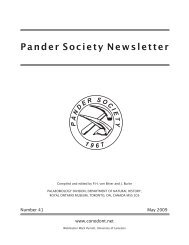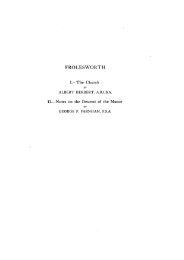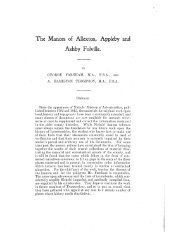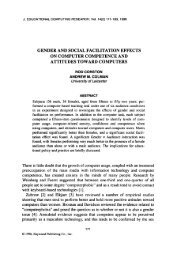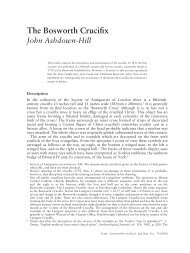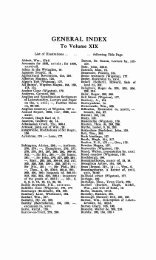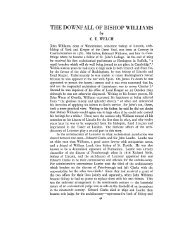Pander Society Newsletter - University of Leicester
Pander Society Newsletter - University of Leicester
Pander Society Newsletter - University of Leicester
You also want an ePaper? Increase the reach of your titles
YUMPU automatically turns print PDFs into web optimized ePapers that Google loves.
asal conglomerate (in relation with the Triassic sealing <strong>of</strong> the post-accretionary Kurosegawa Terrane,<br />
Outer Zone <strong>of</strong> SW Japan) has been published (Ishida et al., 2005). Provenance <strong>of</strong> the Triassic conodontbearing<br />
gravels in the Lower Jurassic cover formation <strong>of</strong> the Mae Sariang Zone was discussed with special<br />
respect to the sealing and erosional event <strong>of</strong> the Shan Thai Terrane (Ishida et al., 2005). The Triassic<br />
(Carnian-Norian) conodont biostratigraphy <strong>of</strong> the meta-chert succession in the Mino-Tamba Jurassic<br />
accretion terrane (Inner Zone <strong>of</strong> SW Japan) will now be studied (Mikami et al., 2006).<br />
Yukio Isozaki. Currently working on detailed stratigraphy <strong>of</strong> the Guadalupian-Lopingian (=Middle-Upper<br />
Permian) boundary interval and the Lopingian/Induan (=Permian-Triassic) boundary interval in South<br />
China and in Japan.<br />
Nadezhda G. Izokh. Study <strong>of</strong> conodonts from Ordovician, Silurian and Devonian <strong>of</strong> the Altai-Sayan<br />
folded area, West Siberia, Russia and South Tien Shan.<br />
Lennart Jeppsson. Collecting and processing work on the Linde and Klev events, and on the recently<br />
discovered early Wenlock Ansarve event has yielded much new data. This is critical for achieving a highresolution<br />
stratigraphy for these intervals, to identify localities for future work (on other major clades,<br />
isotopic and sedimentological changes), to judge the strength <strong>of</strong> these events, and, not least, to reveal how<br />
badly conodonts fared during these events. Manuscripts include papers now in the list <strong>of</strong> publications (see<br />
also Calner et al.), the submitted one and the subzones <strong>of</strong> the O. s. rhenana Zone. These can be followed<br />
across different facies belts in the Silurian sequence <strong>of</strong> Gotland. Application <strong>of</strong> them result in unexpected<br />
large revisions in the local stratigraphy, but also makes the range <strong>of</strong> other clades conform with those found<br />
elsewhere.<br />
David Ian Johnston. A paper on disrupted conodont bedding plane assemblages from the Mississippian <strong>of</strong><br />
western Canada by Charles Henderson and myself has been published. We also presented a poster on this<br />
topic at the AAPG meeting in Calgary this past June. I have also been doing some biostratigraphic service<br />
work involving conodonts this year as well. Working on another manuscript (with C. Henderson)<br />
concerning the conodont biostratigraphy and the implications for sequence stratigraphy for the upper<br />
Wabamun Group to lower Banff Formation interval in the surface and subsurface <strong>of</strong> southern Alberta. The<br />
work is based on the MSc thesis <strong>of</strong> C. Henderson’s recent graduate student Michael Schmidt. I am now<br />
involved in non-conodont work by providing services in petroleum geology.<br />
David Jones. Working on morphometric analysis <strong>of</strong> Ozarkodina excavata and Pterospathodus to examine<br />
taxonomy, population variation and evolutionary rates, patterns and processes.<br />
Gareth Ll. Jones. Mineral exploration activities in Ireland only just begun to lift again, lagging behind the<br />
recovery in zinc prices. I look forward to working with conodonts (and foraminifers, algae, etc.) in 2006.<br />
Meanwhile geothermal exploration is keeping me warm!<br />
Jun Chen. In order to know more about Late Permian-Early Triassic conodonts from Meishan Section<br />
(GSSP), South China, especially the evolutionary status <strong>of</strong> genera Clarkina, many samples have been<br />
collected and processed. Abundant specimens have been picked from these residues. Now working on my<br />
thesis (under Pr<strong>of</strong>. Charles M. Henderson, Calgary, Canada) and hopefully will be completed by mid-2006.<br />
Tea Kolar-Jurkov�ek. Most <strong>of</strong> my projects on Triassic biostratigraphic studies in Slovenia and Croatia<br />
continue collaboratively with my colleagues. An intensive study <strong>of</strong> the P-T interval and Lower Triassic is<br />
in progress in many sections <strong>of</strong> the Dinarides in order to define the systemic boundary biostratigraphically.<br />
Micropaleontological study <strong>of</strong> two sections in the Raibl Beds (Carnian) <strong>of</strong> Slovenia have been published; 1)<br />
a conodont apparatus <strong>of</strong> Nicoraella ? budaensis is demonstrated from the Belca section; and 2) some new<br />
gastropod taxa are recognized from the two assemblages <strong>of</strong> the Mezica area.<br />
Erik Cowing Katvala. Most <strong>of</strong> my work to date has focused on using biostratigraphic, paleoecologic, and<br />
paleogeographic data from Mississippian through Triassic conodonts to help constrain paleontologic,<br />
stratigraphic and tectonic interpretations in the accreted terranes <strong>of</strong> western North America. I have also<br />
been working on element distributions in conodont elements on the electron microprobe.<br />
Ali Murat Kilic. Working on the Triassic conodonts from the Kocaeli & Karaburun peninsulas, Taurids,<br />
Bulgaria and Japan with Pr<strong>of</strong>s. K. Budurov & F. Hirsch.<br />
William Kirchgasser. Work continues on conodont and microvertebrate fossils <strong>of</strong> the ‘Conodont Bed’<br />
(North Evans Limestone) around the Givetian/Frasnian boundary in western New York. A manuscript with<br />
G. Klapper on the Frasnian conodont sequence in New York is in prep. Work continues on the conodontgoniatite<br />
associations in the lower Frasnian <strong>of</strong> Pennsylvania, a project being conducted in collaboration<br />
with Gordon Bair (SUNY Fredonia) and Carl Brett (Univ. <strong>of</strong> Cincinnati).<br />
Elena M. Kirilishina. Research on the conodonts from Frasnian-Famenian boundary interval <strong>of</strong> central<br />
regions <strong>of</strong> the Russian Platform.<br />
16



